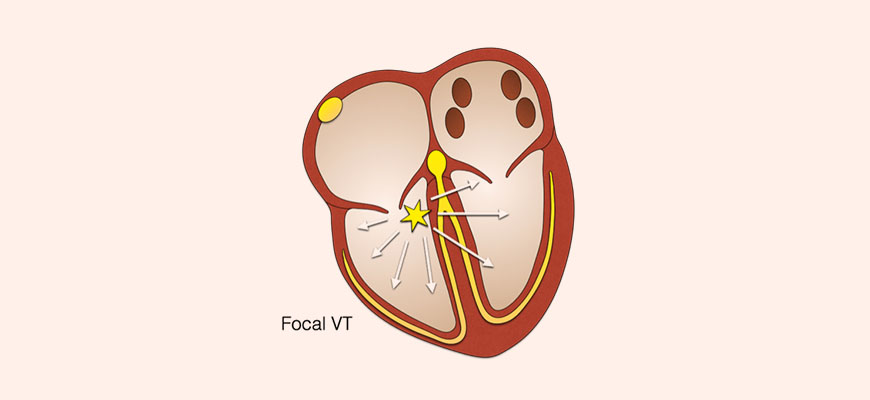VT & VE in Normal Hearts
What are VT and VE?
Ventricular tachycardia (VT) refers to an abnormal rapid heart rhythm originating from the heart’s lower chambers. VT can occur in an otherwise normal, healthy heart. Doctors call this “idiopathic” VT, meaning that the underlying cause of VT is not known. In the large majority of cases, idiopathic VT carries no serious health risks and can be controlled with medications or cured with a medical procedure called catheter ablation.
Sometimes, the abnormal focus may fire single extra beats at a time rather than multiple beats in a row. These isolated extra beats are called ventricular ectopic beats (VE) or premature ventricular contractions (PVCs). Usually, these do not require treatment. However, if they are numerous or highly symptomatic, then treatment is similar to that of idiopathic VT.
How does idiopathic VT occur?
Idiopathic VT occurs when a small cluster of cells in the heart’s lower chambers develops the ability to fire spontaneously. This abnormal “focus” of excitable cells may send out a series of rapid electrical impulses muscle twitch, taking over the heart’s normal rhythm. When this occurs the heart will suddenly start racing. The heart rate is usually over 130 beats per minute and sometimes over 200 beats per minute.
Some individuals can identify triggers, such as caffeine, alcohol, anxiety, and exercise. However, these episodes often occur at any time without a trigger. During an episode, you will usually be aware of your heart beating rapidly. Other symptoms include dizziness, shortness of breath, sweating, chest pain and anxiety. Blackouts may occur but are unusual.
It is not known when or why the abnormal VT (or VE) focus develops, but there are common locations where the abnormal focus can be found. This is usually in the outflow tract of the right ventricle, and sometimes in the left ventricle or on the surface of the heart.
In rare cases, idiopathic VT may result from a short circuit within the heart’s lower chambers, rather than an abnormally excitable focus.
Is idiopathic VT dangerous?
In the large majority of cases, idiopathic VT (and VE) is a benign condition. This means that it will not cause sudden death, will not damage the heart or cause a heart attack, and will not shorten life span.
In some individuals with frequent VT or VE, the abnormal beats result in weakening of the heart muscle which may progress to heart failure. Early treatment is important to prevent deterioration and allow recovery of the heart’s strength.
There are rare cases where idiopathic VT can be dangerous and this will be discussed with you if relevant.
What tests do I need if I have VT?
You may require the following initial tests:
- Blood tests – To determine if there is an underlying condition that has provoked your arrhythmia, such as thyroid or electrolyte disturbances and to check the condition of your liver and kidneys.
- ECG – To evaluate your heart rhythm.
- Holter monitor – To evaluate your heart rhythm over a 24 h period. If you are in normal rhythm, this may reveal ventricular ectopic beats, episodes of VT, or other arrhythmias that correspond with your symptoms. This may also reveal episodes of arrhythmia which you are unaware of.
- Echocardiogram – To evaluate the structure and function of your beating heart. In idiopathic VT, we would expect no abnormalities on echo.
- Cardiac MRI – A Cardiac MRI examines the heart in more detail than echo. While not always necessary, it is sometimes used to confirm that the heart is structurally sound.
Learn more about the different Heart Tests here.
How is idiopathic VT (or VE) treated?
There are 3 main options for people with VT or VE.
- No treatment at all. Idiopathic VT and VE are almost always benign. For those people having very infrequent and short-lived episodes that are not troublesome, one option is to simply live with it.
- Medication. For people who do not wish to continue having episodes, a second option is to take a regular medication to suppress the abnormal heart rhythm. This will improve symptoms but will not cure the problem. There is also the possibility of developing side-effects from these drugs.
- Catheter ablation. This is a procedure that cures the condition by using a keyhole instrument called a “catheter” to deliver radiofrequency energy to ablate (destroy) the abnormal tissue responsible for the VT.
